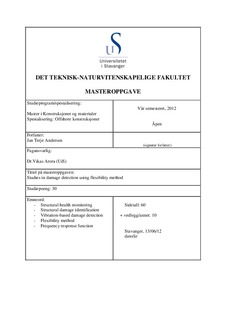| dc.contributor.author | Andersen, Jan Terje | |
| dc.date.accessioned | 2012-10-11T12:56:21Z | |
| dc.date.available | 2012-10-11T12:56:21Z | |
| dc.date.issued | 2012 | |
| dc.identifier.uri | http://hdl.handle.net/11250/182912 | |
| dc.description | Master's thesis in Offshore structural engineering | no_NO |
| dc.description.abstract | Structural health monitoring (SHM) is a way of implementing a system that can monitor, and provide data to help engineers secure the integrity of different structures like civil infrastructure, bridges, offshore structures and aerospace structures. The main purpose of SHM is to detect damages in structures before they become so large that they threaten the integrity and the functionality of the structure. After natural disasters like hurricanes and tsunamis, there is always an uncertainty in the health and safety of structures that has been exposed in some way by these natural phenomena. SHM might in these cases be tool that can assist in determining the integrity of the structure. For aging and deterioration structures SHM can be used to help determine the remaining lifetime of the structure. The main subjects involved in SHM are detection of damage, its location and determination of the severity.
SHM techniques might be based on changes in the structural dynamical characteristics (measured by experimental mechanical vibrations), impedance and non-destructive evaluation methods (NDE).
In this thesis, the flexibility method, which is a vibration-based damage detection method, is tested to determine the pros and cons of applying the method to a SHM system.
The method is tested on a fixed-fixed beam structure. By using this method the identification of damage is determined from the change in frequency response data, obtained from frequency response functions (FRF). The location of the damage is determined by the flexibility diagrams.
A finite element model (FE-model) of the fixed-fixed beam structure is made in the numerical computing software MATLAB. The beam is modeled with two-noded finite beam elements, and the damage is detected and located by the flexibility method for different damage cases simulated in the FE-model. The damages are implemented by reducing the E-modulus of one or more of the two-noded finite beam elements. The dynamical characteristics of the beam structure are obtained from simulated mechanical vibrations, where different frequencies of vibration are tested. The accuracy of the flexibility method is tested for all damage scenarios.
From this investigation it can be concluded that there are both advantages and disadvantages when using the method to detect damages. FRF can for instance only determine if there is damage present in a structure. The flexibility method is not able to determine the severity of the damage. The flexibility method is also less accurate when a structure is subjected to multiple damages that lie in close vicinity to each other. If the beam has two damages present, and the severity of one of the damages is greater than the other, then the damage with the highest severity is easier to detect compared to the other. | no_NO |
| dc.language.iso | eng | no_NO |
| dc.publisher | University of Stavanger, Norway | no_NO |
| dc.relation.ispartofseries | Masteroppgave/UIS-TN-IKM/2012; | |
| dc.subject | offshore teknologi | no_NO |
| dc.subject | konstruksjonsteknikk | no_NO |
| dc.subject | offshorekonstruksjoner | no_NO |
| dc.subject | vibration-based damage detection | no_NO |
| dc.subject | frequency response function | no_NO |
| dc.subject | structural health monitoring | no_NO |
| dc.subject | structural damage identification | no_NO |
| dc.subject | flexibility method | no_NO |
| dc.title | Studies in damage detection using flexibility method | no_NO |
| dc.type | Master thesis | no_NO |
| dc.subject.nsi | VDP::Technology: 500 | no_NO |
